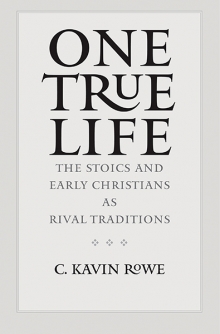C. Kavin Rowe—
One of the greatest mysteries of human life is that we are a problem for ourselves. We tend to act in ways that damage our lives and mess things up. We let our passions run amok, focus on things that don’t matter much rather than on the things that do, get overwhelmed by problems that we have no control over, and—in short—make it difficult for us to get through life well. Not only that. The world itself throws hard things our way, with no detectable reason behind them. It also gives us good things, but, paradoxically perhaps, these goods can increase awareness of our fragility in the face of a seemingly random world. Sometimes good fortune is the name only for the latest turn of events. Disaster lurks around every corner. We remain at the mercy of the world’s great power.
Stoicism was a historically deep tradition that claimed it had the resources to address the problems of human life. In contrast to modern university philosophy courses, where professors do not usually expect their courses to change lives, Stoicism was philosophy in the ancient sense: disciplined knowledge that put its students into a pattern of healing and a better life. It did this through a wide range of ways over several hundred years, but the Roman Stoics in particular are noteworthy for their focus on three things.
They were absolutely insistent on the fact that there are things that are not in our control and that worrying about them will bring us ruin. Divide the world into things that are “in” and “out” of our control, and let the latter go. Focus on what we can control: our passions, our decisions, our thoughts. Sticking to what is in our control protects us from whatever the world brings to our doorstep. We fashion a great wall around ourselves and can live inside our inner fortress. We gain self-possession, freedom from the winds of life, and peaceful security.
They believed that we should face death squarely in the face. It is out of our control, after all. Their teaching, however, was not simply about death in the abstract – “human mortality” – but emphasized meditation on death in the personal sense. The fact that I will die is a different sort of fact than the fact that the human being is mortal. Think on your own death every day, the Stoics taught, and you will learn to see what matters in life.
They also insisted that learning to be a Stoic was best done by becoming an apprentice to a master. They knew the old truth that what people are is the best teacher and that hypocrisy is the worst enemy truth can have. Tell someone money and finery don’t matter, wear a handful of lovely rings, and your teaching becomes worthless. Philosophy was for the Stoics a teaching relationship, or even discipleship. Changing your life is not easy. You need guidance in how teaching is put into practice. So you watch a master live out the Stoic doctrines. Only in this way can you see what the truth of Stoic teaching really is and how it works to repair our lives.
C. Kavin Rowe is professor of New Testament at Duke University Divinity School and the author of Early Narrative Christology: The Lord in the Gospel of Luke and World Upside Down: Reading Acts in the Graeco-Roman Age. He lives in Durham, NC.
Further reading:



 Deobandism, Islam and the Religious Narratives of the Taliban
Deobandism, Islam and the Religious Narratives of the Taliban